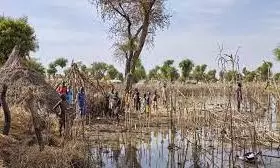
43.1 million children displaced by climate disasters from 2016 to 2021: UNICEF
text_fieldsWeather-related disasters exacerbated by climate change, including floods, storms, droughts, and wildfires, have resulted in the displacement of 43.1 million children between 2016 and 2021, according to a comprehensive report by the United Nations Children's Fund (UNICEF).
The report underscores the often-overlooked plight of children affected by climate-induced events and highlights the profound consequences of these displacements.
The report provides heart-wrenching accounts of some of the children impacted by climate disasters, shedding light on their struggles. The data presented is seen as merely the "tip of the iceberg," with many more children likely experiencing similar challenges, reported AFP.
Khalid Abdul Azim, a Sudanese child, described the situation in his flooded village, where families had to relocate to the highway and live for weeks, as their village became accessible only by boat.
Similarly, sisters Mia and Maia Bravo from California recounted the traumatic experience of watching their trailer engulfed in flames from the family minivan during a wildfire. Maia expressed her fear and shock, stating that she would stay awake all night.
While statistics on internal displacements caused by climate disasters often do not specify the age of the victims, UNICEF collaborated with the non-governmental Internal Displacement Monitoring Center to disaggregate the data, revealing the hidden impact on children.
The report indicates that climate disasters, including floods, storms, droughts, and wildfires, driven by global warming, led to the displacement of 43.1 million children in 44 countries during the specified period.
A staggering 95% of these displacements resulted from floods and storms.
Laura Healy, a co-author of the report, emphasised that this equates to approximately 20,000 child displacements daily, underscoring the immense challenges faced by these children. Furthermore, displaced children are susceptible to additional traumas, such as separation from their parents and exploitation by child traffickers.
The figures represent the number of displacements and not the number of children affected, as the same child may experience displacement multiple times.
The data does not differentiate between evacuations before a weather event and displacements occurring after a disaster.
Healy pointed out that displacements due to drought are likely "radically underreported" because they tend to be less sudden and, therefore, more challenging to quantify. She emphasised that the available data only scratches the surface of the problem, and the number of children uprooted due to climate change is expected to increase significantly.
The UNICEF report offers some predictions for specific events, estimating that flooding from overflowing rivers could lead to 96 million child displacements over the next 30 years, while cyclonic winds and storm surges could result in 10.3 million and 7.2 million displacements, respectively, not accounting for preventive evacuations.
UNICEF called upon world leaders to address this critical issue at the upcoming COP28 climate summit in Dubai in November and December.
Healy stressed the need to prepare children, including those already displaced, to live in a world altered by climate change. While climate change's intensifying effects affect large parts of the planet, the report highlights the heightened vulnerability of specific countries.
China, India, and the Philippines reported the highest number of displacements (nearly 23 million) during the six years, largely due to their large populations, geographical locations, and preventive evacuation plans.
In terms of proportion, Africa and small island nations face the greatest risk, with Dominica reporting that 76% of all children were displaced between 2016 and 2021. Similarly, Cuba and Saint-Martin saw over 30% of their children displaced during the same period.























